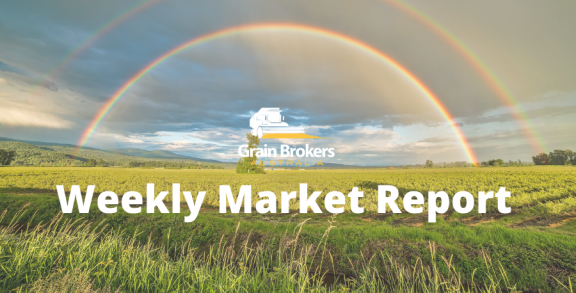
Favourable spring and early summer temperatures combined with above-average soil moisture in most regions have boosted yield estimates for the European Union’s winter and spring crops, with the outlook now sitting well above the five-year average.
Once the cooler temperatures of May gave way to warmer days throughout June, crop development accelerated, and extended grain fill periods are being experienced in many districts. There are parts of Italy and Portugal that have been on the dry side, but below-average temperatures have limited negative impacts.
On the flip side, parts of the Baltic and neighbouring regions have been relatively wet, which has limited yield potential. Excessive cloud cover in northern Germany and southern Denmark has limited radiation during the critical flowering period, slightly decreasing yield potential as a result.
According to the latest crop monitoring bulletin from JRC MARS, this year’s wheat harvest will average 5.79 metric tonne per hectare (MT/ha). This is 1.6 per cent higher than the May projection of 5.70MT/ha and sits 5.8 per cent above the five-year average of 5.47MT/ha.
The big winner has been the soft wheat crop where the average yield is forecast at 6.01MT/ha, 1.7 per cent higher than the May number and 5.6 per cent higher than the five-year average of 5.69T/ha. The yield increase in the durum wheat crop is not as impressive, with MARS calling it 3.57MT/ha this year, just 2.2 per cent above the five-year average of 3.49MT/ha.
On the barley front, MARS is predicting an average yield of 4.97MT/ha, 4.2 per cent higher than the five-year average of 4.77MT/ha. Looking at the breakdown, it is definitely the spring planted crops that are letting the team down. The winter and spring barley crops are predicted to yield 5.9MT/ha and 4.28MT/ha, respectively, 4.9 per cent and 3.9 per cent above the five-year average.
Like the Tour de France, which commenced in the northwest of the country on the weekend, so too the French winter crop harvest has begun. On Friday of last week, FranceAgriMer advised that one per cent of the winter barley crop was in the bin as of June 21, down from two per cent on the same week in 2020.
The French farm office also released their latest wheat and barley crop ratings with a slight deterioration across the board in the week to June 21. Nevertheless, the crop is still sitting above average for this time in the season, and there is expected to be a sharp rebound in production compared to the poor harvest in 2020.
The soft wheat crop rating came in at 79 per cent good-to-excellent, down from 81 per cent a week earlier. The durum wheat rating fell three percentage points week-on-week to 67 per cent good-to-excellent. The winter barley crop was rated 75 per cent good-to-excellent, down one per cent on the June 14 rating. On the whole, the spring barley crop is in better condition at 84 per cent good-to-excellent, but it did lose two percentage points across the week.
In Germany, the wheat, barley and rapeseed crops all suffered from below-average growth in the cool early spring weather, but a much warmer June and good soil moisture has enabled crops in most regions to catch up. According to Germany’s Association of Farm Co-operatives, the crops were about two to three weeks behind normal development in May but are now only about one week to ten days behind.
The European Commission updated production estimates for its 27 member countries last Thursday. The output of what they refer to as usable soft wheat was trimmed by 0.4 million metric tonne (MMT) to 125.8MMT compared to the agency’s May forecast. If realised, that would put the 2021 crop 7.3 per cent higher than the drought-affected total of 117.2MMT last year.
The Commission pegged soft wheat exports from the EU-27 at 30 million tonnes for the 2021-22 marketing year, which commences in the back end of this week on July 1. This represents an 11 per cent increase on the 27MMT of wheat exports projected in the current marketing year.
However, a couple of key internal EU wheat demand categories were also revised higher in this month’s report. The quantity of wheat expected to be used in stockfeed rations and biofuel both increased by 300,000 metric tonne to 41.3MMT and 3.4MMT, respectively.
Meanwhile, the Commission expects wheat imports into the EU-27 to total 2.7MMT in the coming marketing year. Ending stocks are expected to total 10.1MMT on June 30, 2022, down from the May estimate of 10.8MMT but 22.7 per cent higher than the 8.8MMT likely to be in reserve when the 2020-21 marketing year concludes this week.
According to the Commission, usable barley production across the EU member states is forecast at 53.5MMT, down 1 MMT from the May estimate and 6.0 per cent lower than the final 2020/21 production number. The Commission revised last year’s barley harvest 2.1MMT higher to 56.9MMT on the back of robust exports but ample supply. This pushed ending stocks for the 2021/22 marketing year to 8.4MMT compared to 6.8MMT in last month’s report.
On the rapeseed front, the Commission left its May production estimate unchanged at 16.7MMT in last week’s update. However, it did raise member country imports by 400,000 metric tonne to 62MMT in 2021/22, on par with imports in the current marketing year.
Higher production will be the order of the day across the 27 European Union member states this harvest. This should see export volumes, particularly from France, into traditional northern African homes return to pre-drought levels. No doubt competition from the Black Sea region will be intense as the region forges new export partnerships, but there is always China as the French so readily entertained in the current marketing year.
Call your local Grain Brokers Australia representative on 1300 946 544 to discuss your grain marketing needs.





